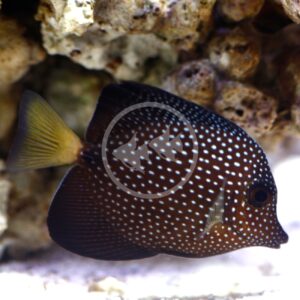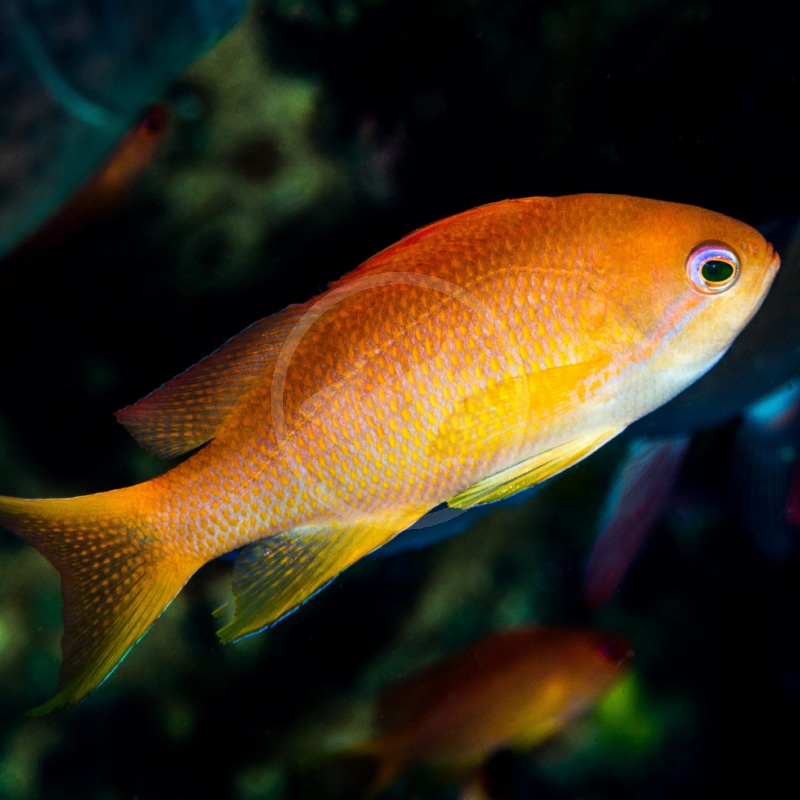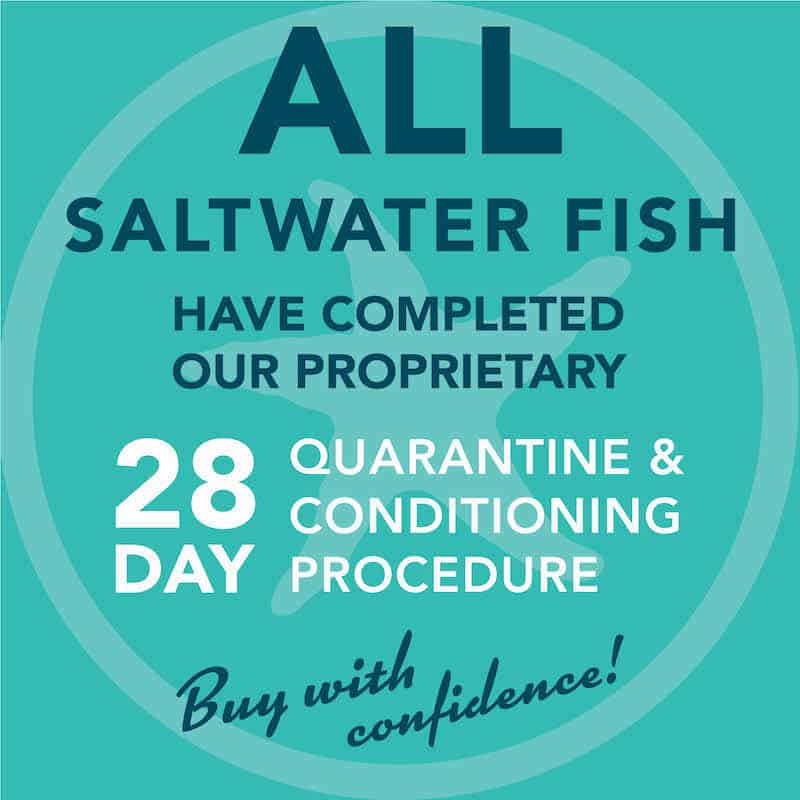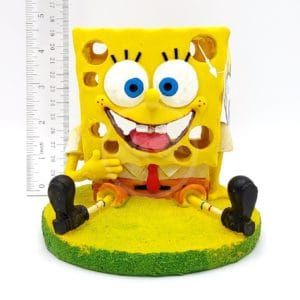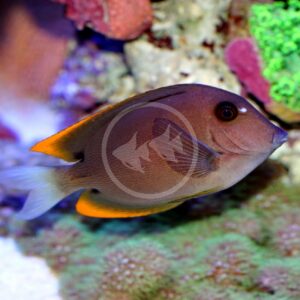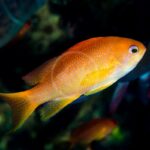
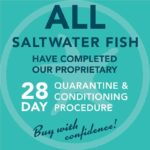
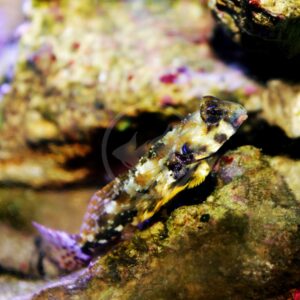
ANTHIAS – BLOOD SPOT / YELLOW LINED Pseudanthias luzonensis
$89.99
The Yellow Lined Anthias, also known as Luzon or Blood Spot Anthias, are found in the Indo-Pacific. They’re named accordingly for their few distinct orange-yellow lines that run horizontally along the top of their bodies. The nickname, Blood Spot, is also appropriate for the bold red marking in the dorsal fin of males. Yellow lined anthias are typically found at depths of up to 200 feet, making this anthias species infrequently available. Admired for their shoaling and colorful presence in the aquarium, anthias can be high maintenance [particularly at first] due to their environmental and dietary requirements (see sections below). Like all anthias species, the Yellow lined anthias are hermaphroditic. This means that if the male of the group perishes, the dominant or largest female will change into a male to take its place. Male and female Yellow lined anthias look similar, with the exception that males will have more elaborate and longer pelvic fins in this species. Anthias thrive best in groups of at least 6 individuals, but more are encouraged. If a male is identifiable, it is best to keep him with multiple females as more than one male will quarrel for dominance. Yellow lined anthias do best as the only anthias species in an aquarium. An adult Yellow lined anthias can grow to approximately 5″. Note: Anthias are known to be susceptible to bacterial and protozoan infections. Our rigorous 28 day quarantine process eliminates these concerns when you purchase anthias from Aquatics Unlimited.
Out of stock
Care Level: Moderate
Temperament: Semi-Aggressive
Reef Compatible: Yes
General Description: The Yellow Lined Anthias, also known as Luzon or Blood Spot Anthias, are found in the Indo-Pacific. They’re named accordingly for their few distinct orange-yellow lines that run horizontally along the top of their bodies. The nickname, Blood Spot, is also appropriate for the bold red marking in their dorsal fin. Yellow lined anthias are typically found at depths of up to 200 feet, making this anthias species infrequently available. Admired for their shoaling and colorful presence in the aquarium, anthias can be high maintenance [particularly at first] due to their environmental and dietary requirements (see sections below). Like all anthias species, the Yellow lined anthias are hermaphroditic. This means that if the male of the group perishes, the dominant or largest female will change into a male to take its place. Male and female Yellow lined anthias look similar, with the exception that males will have more elaborate and longer pelvic fins in this species. Anthias thrive best in groups of at least 6 individuals, but more are encouraged. If a male is identifiable, it is best to keep him with multiple females as more than one male will quarrel for dominance. Yellow lined anthias do best as the only anthias species in an aquarium. An adult Yellow lined anthias can grow to approximately 5″. Note: Anthias are known to be susceptible to bacterial and protozoan infections. Our rigorous 28 day quarantine process eliminates these concerns when you purchase anthias from Aquatics Unlimited.
Diet Requirements: In the wild anthias are zooplanktivores. This specific diet can be tricky to replicate, but an aquarium with a refugium that has a healthy population of copepods can greatly benefit your anthias. Additionally, a varied diet of high quality frozen foods such as brine shrimp, rotifers, calanus, mysis shrimp and other mixed preparations are important for best coloration, immune function and optimal health. We highly encourage soaking frozen foods in vitamin and fatty acid supplements given the activity level of anthias. Offering multiple, small feedings throughout the day can also be beneficial for maintaining anthias health and better replicate their natural feeding behaviors in the wild. Note: All of our anthias for sale are eating a combination of live foods and frozen foods, or frozen foods only. It is not uncommon for anthias to revert back to only accepting live foods for a period of time due to the stress of a new environment.
Care Requirements: An established minimum 125 gallon aquarium is ideal for a group of Yellow lined anthias; size up accordingly to accomodate a much larger shoal. Anthias require a set-up with live rock because it can provide some of the necessary microfauna to help keep them healthy. While anthias do spend the majority of their time in the open water column, they do appreciate some live rock slopes and overhangs to take refuge. Because Yellow lined anthias come from high flow areas in the wild, they prefer similar water movement in the aquarium. It is generally advised to provide hefty filtration and a protein skimmer for an aquarium with anthias. Given their peaceful nature, Yellow lined anthias should not be kept with overly large and aggressive species. It is also best practice to keep only one type of anthias per aquarium to avoid interspecific aggression and competition. Anthias make excellent reef inhabitants and would feel the most at home in this kind of setting; they will not bother coral or invertebrates. Once settled in and feeding well, Yellow lined anthias will surely be a center piece of your aquarium. Recommended water conditions, 72-78° F, KH 8-12, pH 8.1-8.4, salinity 1.020-1.025.
Purchase Size: Small: 1-1/2″ to 2″; Medium: 2″ to 3-1/2″
Note: Your item may not look identical to the image provided due to variation within species. Purchase sizes are approximate.
Dry goods orders are shipped via US Postal Service or UPS to the address provided at checkout based on the selection made in your website shopping cart. Product is carefully packed to help prevent any damage during shipping. Once processed you will receive a shipment notification via email with tracking number, and delivery notification. Please allow 48 hours for processing after your order is placed.
Perishable items (i.e. live plants, refrigerated/frozen foods) are shipped via US Postal Service 2-3 day to the address provided at checkout for a $25.00 flat rate charge. Items are packed with secure packing material and heat, cold, or Cryo packs as needed to maintain safe temperatures during transit. If one or more perishable items are in the shopping cart at checkout the $25.00 perishable shipping charge will automatically appear and need to be selected. Once processed you will receive a shipment notification via email with tracking number. Please allow 48 hours for processing after your order is placed.
Livestock (i.e. fish, invertebrates, coral) are shipped via UPS Overnight to the address provided at checkout for a $55.00 flat rate charge. Livestock is packed in insulated styrofoam boxes with secure packing material and heat, cold, or Cryo packs as needed to maintain safe temperatures during transit. If one or more livestock items are in the shopping cart at checkout the $55.00 livestock shipping charge will automatically appear and need to be selected. Livestock is shipped Monday through Wednesday ONLY (no weekend delivery is available) weather permitting, and we reserve the right to delay shipping until conditions are appropriate for safe arrival. Once your order is placed we will contact you to arrange the best shipping date based on these criteria. Someone must be available to receive the livestock order on the first delivery attempt. Once processed you will receive a shipment notification via email with tracking number. Please allow 48 hours for processing after your order is placed.
For mixed dry goods/perishable & livestock orders items will be shipped via their corresponding shipping methods outlined above. Dry goods will be shipped via US Postal Service or UPS based on your selection and checkout, while livestock will ship via UPS Overnight for a $55.00 flat rate charge. You will receive separate notifications and tracking numbers for the dry goods and livestock. Please note due to different carriers and shipping methods dry goods and livestock may arrive on different days.
Related products
TANG – SAILFIN Zebrasoma veliferum
$99.99 – $199.99Price range: $99.99 through $199.99TANG – TOMINIENSIS Ctenochaetus tominiensis
$119.99 – $169.99Price range: $119.99 through $169.99
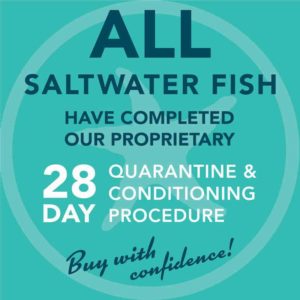
WRASSE – LEOPARD VERMICULATE Macropharyngodon bipartitus
$129.99

TRIGGER – HUMU HUMU Rhinecanthus aculeatus
$89.99 – $139.99Price range: $89.99 through $139.99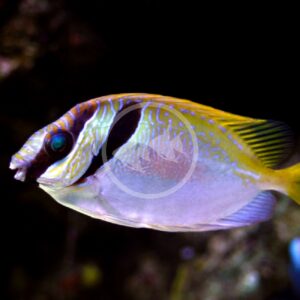

RABBITFISH – TWO BARRED Siganus virgatus
$89.99 – $199.99Price range: $89.99 through $199.99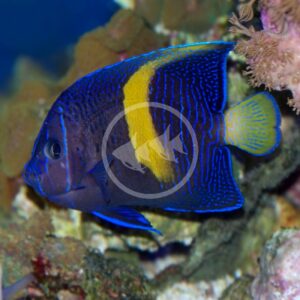

ANGEL – MACULOSUS Pomacanthus maculosus
$254.99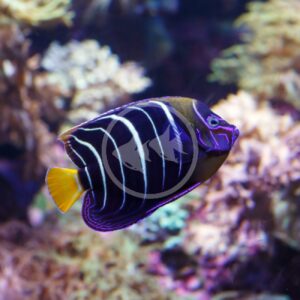

ANGEL – CHRYSURUS Pomacanthus chrysurus
$269.99